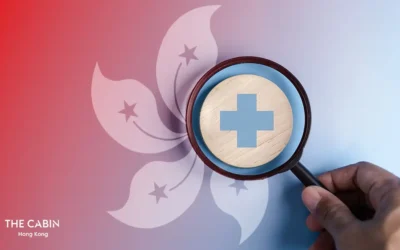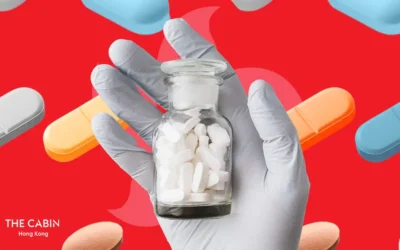In the last 10 years the use of cathinones — aka ‘bath salts’ — has emerged as a serious global issue. Affordable and easily available online, they have resulted in dozens of deaths worldwide. While much remains to be learned about these new designer drugs, here is what we know so far.

Sharelines
Of all the recreational drugs, cathinones are perhaps the ones we know the least about. More commonly known as ‘bath salts’ or ‘legal highs’, the distribution and use of synthetic cathinones has increased significantly in recent years as users seek cheaper and more readily available alternatives to psychoactive drugs such as MDMA and ecstasy.
The emergence of synthetic cathinones has presented a number of challenges for authorities in Hong Kong and around the world. They are often sold online under the guise of bath salts, plant food or even phone screen cleaner to avoid detection. Further, the vast number of these new psychoactive substances (NPS) emerging each year makes international control extremely difficult. Their relative newness also means that cathinone addiction treatment information is sometimes harder for sufferers to come by.
“The unprecedented emergence in recent years of potentially dangerous psychoactive substances that are not under international control has led to their increased abuse, hospital emergency admissions and sometimes fatalities,” the UN Office on Drugs and Crime (UNODC) states in its latest report on the synthetic drug problem.
The Origins and Rise of New Synthetic Substances (NPS)
Synthetic cathinones are human-made drugs derived from cathinone, which is found in the khat plant grown in East Africa and southern Arabia. People in those regions have been known for centuries to chew leaves from the plant for its mild stimulant effects. The effects of synthetic cathinones, however, are much stronger and far more dangerous.
While they were first synthesized in the 1930s, it was not until the first decade of this century that synthetic cathinones emerged as a recreational drug. Their use spiked significantly in 2009 and 2010, first in the UK and Europe, before spreading to the US, Asia and the rest of the world. Their use is also thought to have risen dramatically in Hong Kong during that time.
Methylenedioxypyrovalerone (MDPV), mephedrone and methedrone are the chemicals most often found in bath salts, though they are sold under a variety of street names, such as MCAT, Lunar Wave, Cloud Nine, Purple Wave or Vanilla Sky.
While the usage of synthetic cathinones is notoriously difficult for authorities to track, statistical and anecdotal evidence points to increased prevalence of the drug in many parts of the world. The latest drug use report by the European Monitoring Centre for Drugs and Drug Addiction (EMCDDA) indicates that 8 per cent of respondents indicated they had used synthetic drugs, compared to 5 per cent in 2011.
A study carried out by Joseph J Palamar, an assistant professor of Population Health at NY Langone Medical Center (NYULMC), in 2012-2013 found that 1.1 per cent of high school seniors had used bath salts, with 18 per cent of those using it frequently. Worryingly, the study found that the perceived risk of use increased from 25 per cent in 2012 to 39 per cent in 2013.
Cathinones: Use and Effects
Synthetic cathinones usually come in the form of a crystal-like powder, often looking very similar to real bath salts. Most commonly they are snorted or swallowed, but can also be injected.
Chemically, cathinones are similar to amphetamines, cocaine and MDMA, and produce many similar effects, such as euphoria, increased social interaction and increased sex drive by raising the level of dopamine in brain circuits that control reward and movement. Cathinones are often passed off as MDMA or ecstasy, so it is likely that many people have taken these substances without even knowing it.
While much is still unknown about synthetic cathinones and their effects, it is widely accepted that they can be highly dangerous. Negative effects include depression, anxiety, tremors and hallucinations, with more serious physical effects such as heart problems and kidney failure sometimes leading to death. In 2013, the Drug Abuse Warning Network reported that more than 20,000 drug-related emergency department visits in the US were related to bath salt drugs.
Cathinones and the Law
Despite the inherent difficulties in controlling cathinones, governments around the world have stepped up efforts to legislate against their use since 2010. The Hong Kong government was among the first to act, with “Mephedrone and other cathinone derivatives… controlled under the Dangerous Drugs Ordinance since 1 April 2011,” according to the Hong Kong Police Force website.
In October 2011, the US Drug Enforcement Administration banned three common man-made cathinones pending further research. In July 2012, President Barack Obama signed legislation permanently making mephedrone and MDPV illegal.
Despite these positive moves, tracking the distribution, sale and use of synthetic cathinones remains notoriously difficult and prosecutions are rare in many countries.
Seeking Treatment for Synthetic Drug Abuse in Hong Kong
Research indicates that use of synthetic cathinones can create a strong urge to use them again. Frequent use can lead to tolerance, dependence and intensely uncomfortable withdrawal symptoms such as tremors, depression, anxiety and paranoia.
There is, however, good news for those struggling with cathinones abuse. As the prevalence of the drug has increased in recent years, so too has addiction centers’ ability to deal with withdrawal symptoms and plan effective treatment programs.
The Cabin Hong Kong provides confidential, holistic and effective treatment for sufferers of synthetic drug addiction. Contact us today to find out how we can help you take the first step toward recovery.




